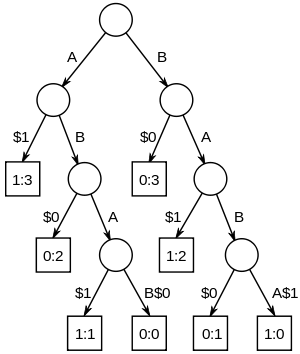Generalized suffix tree
In computer science, a generalized suffix tree is a suffix tree for a set of strings. Given the set of strings of total length , it is a Patricia tree containing all suffixes of the strings. It is mostly used in bioinformatics.[1]

Functionality
It can be built in time and space, and can be used to find all occurrences of a string of length in time, which is asymptotically optimal (assuming the size of the alphabet is constant[2]:119).
When constructing such a tree, each string should be padded with a unique out-of-alphabet marker symbol (or string) to ensure no suffix is a substring of another, guaranteeing each suffix is represented by a unique leaf node.
Algorithms for constructing a GST include Ukkonen's algorithm (1995) and McCreight's algorithm (1976).
Example
A suffix tree for the strings ABAB and BABA is shown in a figure above. They are padded with the unique terminator strings $0 and $1. The numbers in the leaf nodes are string number and starting position. Notice how a left to right traversal of the leaf nodes corresponds to the sorted order of the suffixes. The terminators might be strings or unique single symbols. Edges on $ from the root are left out in this example.
Alternatives
An alternative to building a generalized suffix tree is to concatenate the strings, and build a regular suffix tree or suffix array for the resulting string. When hits are evaluated after a search, global positions are mapped into documents and local positions with some algorithm and/or data structure, such as a binary search in the starting/ending positions of the documents.
References
- Paul Bieganski; John Riedl; John Carlis; Ernest F. Retzel (1994). "Generalized Suffix Trees for Biological Sequence Data". Biotechnology Computing, Proceedings of the Twenty-Seventh Hawaii International Conference on. pp. 35–44. doi:10.1109/HICSS.1994.323593.
- Gusfield, Dan (1999) [1997]. Algorithms on Strings, Trees and Sequences: Computer Science and Computational Biology. USA: Cambridge University Press. ISBN 978-0-521-58519-4.
External links

- A C implementation of Generalized Suffix Tree for two strings